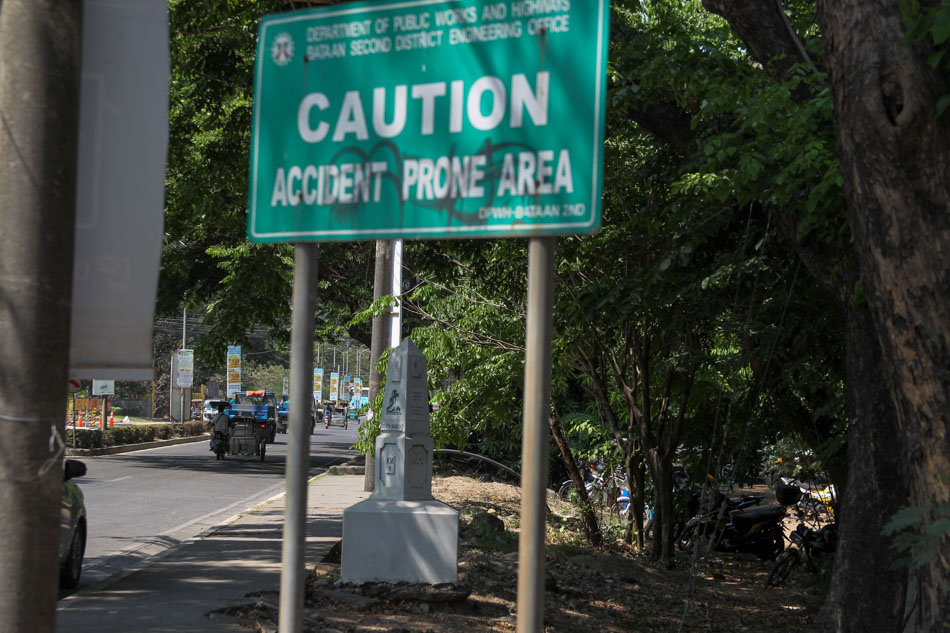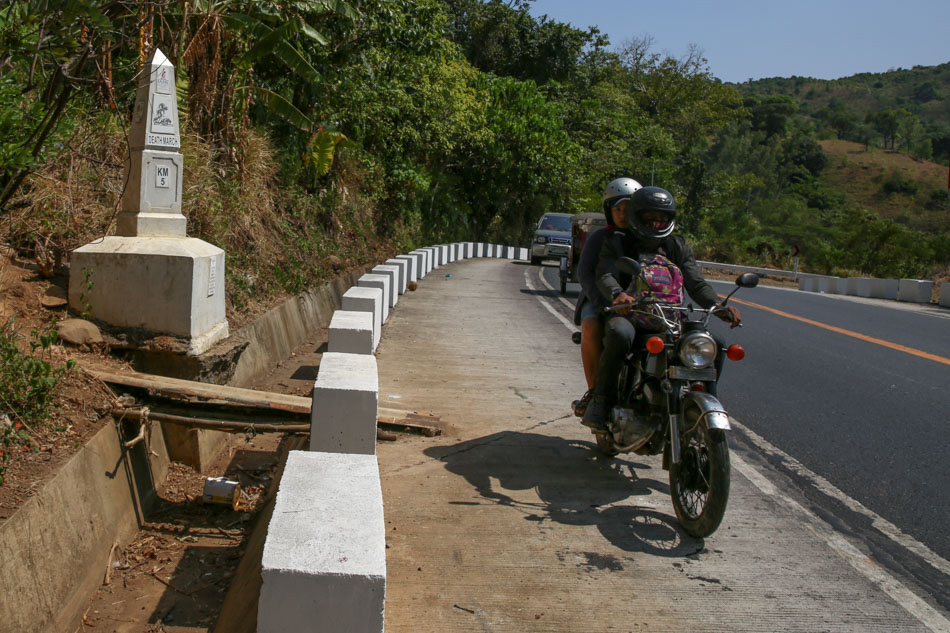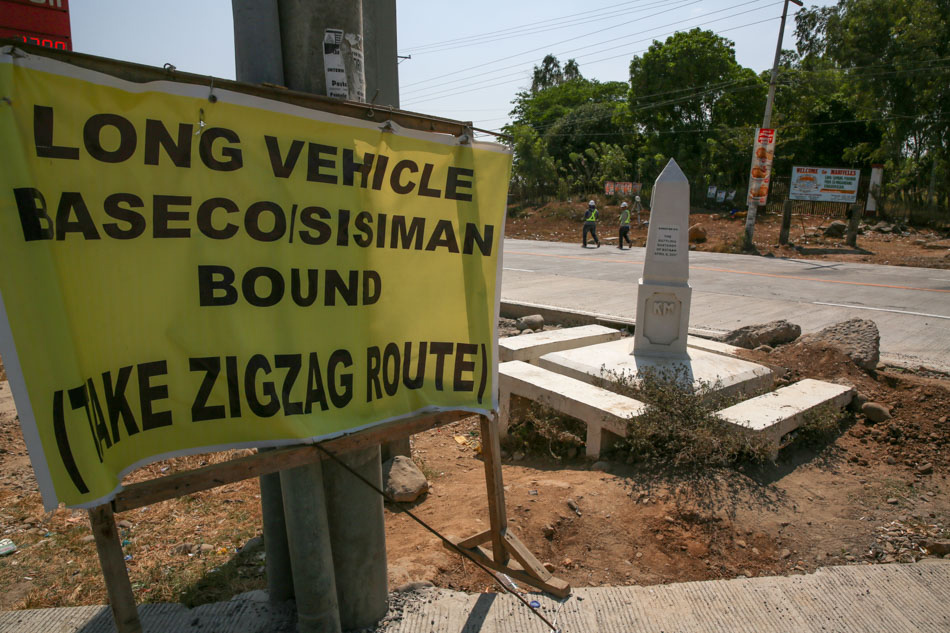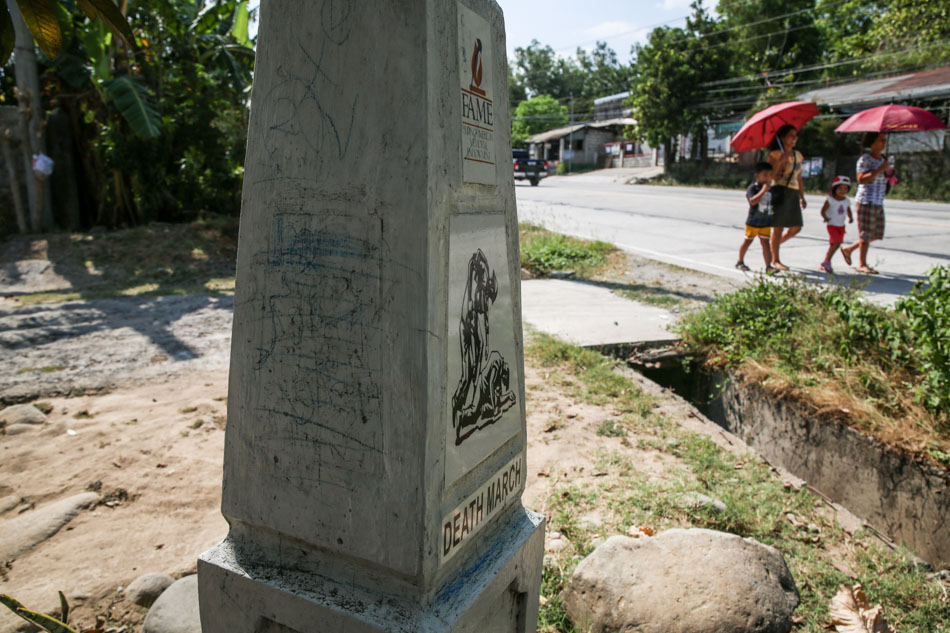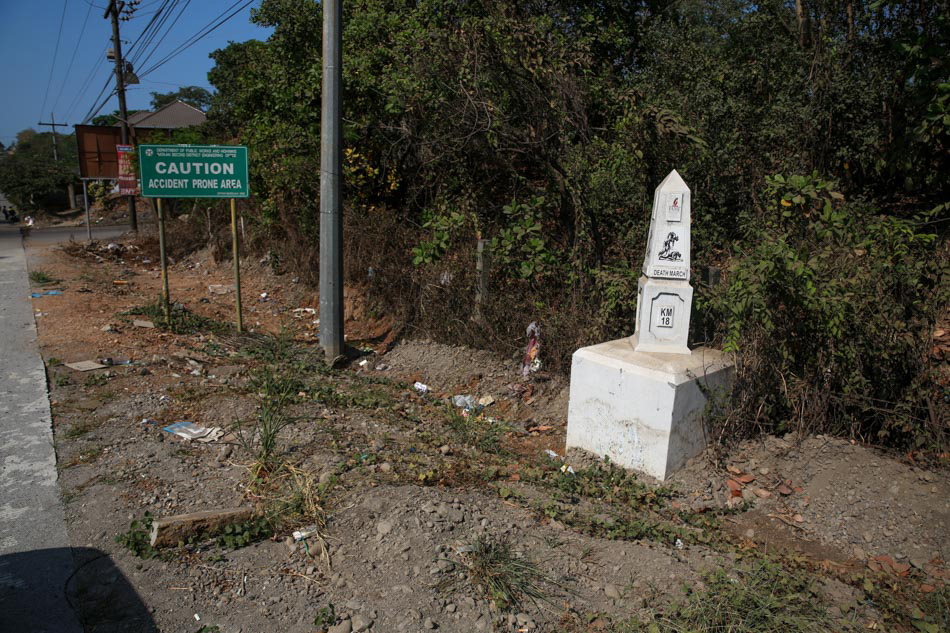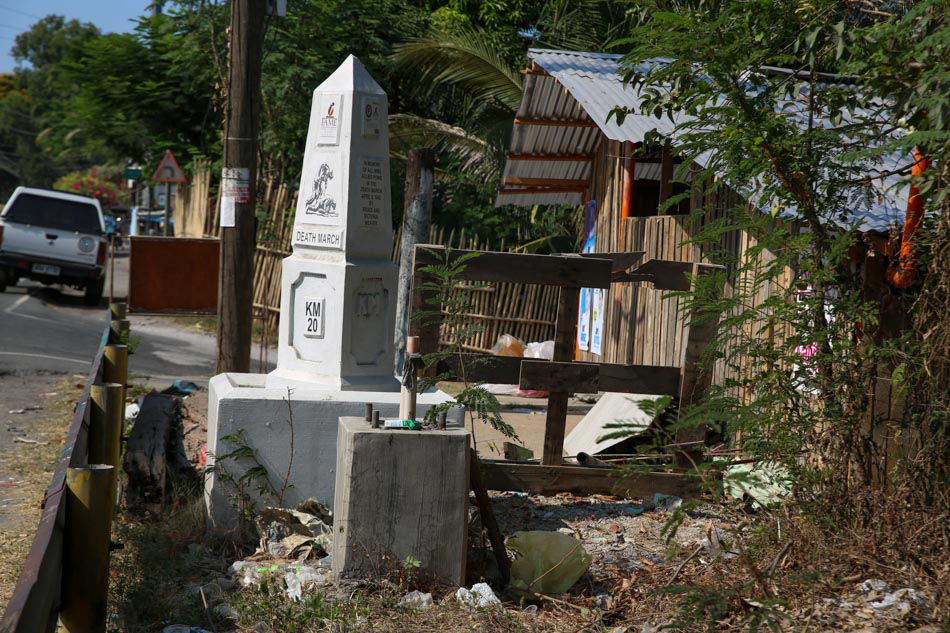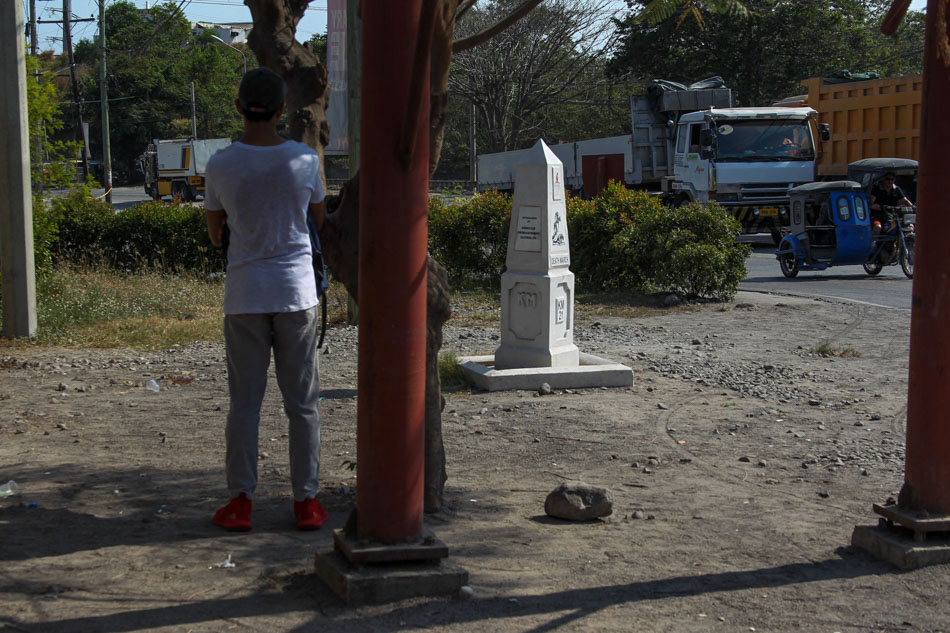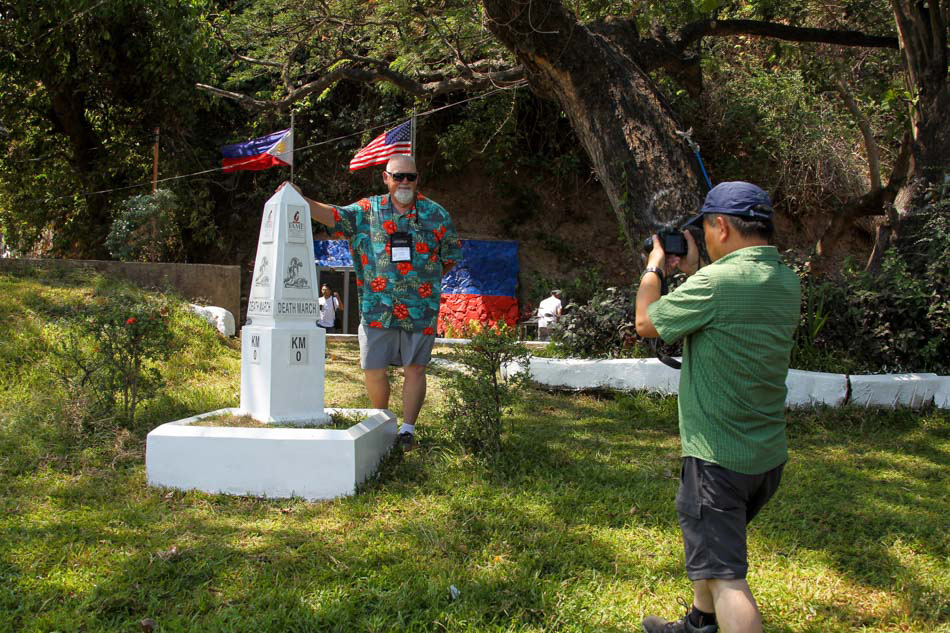Bataan death march markers damaged, forgotten | ABS-CBN
ADVERTISEMENT

Welcome, Kapamilya! We use cookies to improve your browsing experience. Continuing to use this site means you agree to our use of cookies. Tell me more!
Bataan death march markers damaged, forgotten
Bataan death march markers damaged, forgotten
Michael Joe Delizo,
ABS-CBN News
Published Apr 09, 2019 05:48 PM PHT
|
Updated Apr 09, 2019 06:01 PM PHT
BATAAN - It has been 77 years since the grueling Death March of about 75,000 Filipino and American troops in over a hundred kilometer agonizing path from mountainous towns of Mariveles and Bagac in Bataan to Capas, Tarlac.
BATAAN - It has been 77 years since the grueling Death March of about 75,000 Filipino and American troops in over a hundred kilometer agonizing path from mountainous towns of Mariveles and Bagac in Bataan to Capas, Tarlac.
It was considered as one of the darkest period in the Philippine history when the prisoners of war staggered day and night, under blistering sun and cold night sky. Thousands fell and died over the brutality of the Japanese Imperial Army.
It was considered as one of the darkest period in the Philippine history when the prisoners of war staggered day and night, under blistering sun and cold night sky. Thousands fell and died over the brutality of the Japanese Imperial Army.
Ninety-five-year-old Teodoro Guzman vividly remembers the event that left a huge scar in his heart, and recounts the horror every now and then to his children.
Ninety-five-year-old Teodoro Guzman vividly remembers the event that left a huge scar in his heart, and recounts the horror every now and then to his children.
“Habang nagku-kuwento sila sa amin, umiiyak din sila dahil sa naranasan nila,” said Dolores, daughter of Mr. Guzman.
“Habang nagku-kuwento sila sa amin, umiiyak din sila dahil sa naranasan nila,” said Dolores, daughter of Mr. Guzman.
ADVERTISEMENT
(While they are telling us the story, they are also crying because of their experience.)
(While they are telling us the story, they are also crying because of their experience.)
Soon enough, the likes of Guzman will be gone and no one will tell the story firsthand.
Soon enough, the likes of Guzman will be gone and no one will tell the story firsthand.
In a bid to remember the sacrifices of soldiers, 138 markers were installed along the path of the historical march: 97 in Bataan, 33 in Pampanga, and 8 in Tarlac, to the gates of then Camp O’Donnell, now Capas National Shrine.
In a bid to remember the sacrifices of soldiers, 138 markers were installed along the path of the historical march: 97 in Bataan, 33 in Pampanga, and 8 in Tarlac, to the gates of then Camp O’Donnell, now Capas National Shrine.
But these mute mementos are getting ruined and ignored, either due to negligence or modernization through road projects of Department of Public Works and Highways (DPWH).
But these mute mementos are getting ruined and ignored, either due to negligence or modernization through road projects of Department of Public Works and Highways (DPWH).
The Kilometer 9 marker, for instance, was already inside the fence of a residential compound in Barangay Alas-asin, Mariveles. It was moved last year to make way for a drainage ditch, according to a resident.
The Kilometer 9 marker, for instance, was already inside the fence of a residential compound in Barangay Alas-asin, Mariveles. It was moved last year to make way for a drainage ditch, according to a resident.
“Hindi na raw po ibabalik kasi ang sabi po nila, magdadagdag pa ng isang lane dito bale ’yung kanal na ’yan, useless din,” resident Reyniel Delos Santos said.
“Hindi na raw po ibabalik kasi ang sabi po nila, magdadagdag pa ng isang lane dito bale ’yung kanal na ’yan, useless din,” resident Reyniel Delos Santos said.
(They said they will not return it; they will even add another lane on the road so the drainage ditch will be useless.)
(They said they will not return it; they will even add another lane on the road so the drainage ditch will be useless.)
Residents in the area placed stones around the obelisk to protect the marker because the base on which it sat was already destroyed. The marker itself was vandalized, too.
Residents in the area placed stones around the obelisk to protect the marker because the base on which it sat was already destroyed. The marker itself was vandalized, too.
The nearby Kilometer 7’s base was already excavated, its surrounding already covered with rubble. The Kilometer 18 marker, meanwhile, was hiding behind leaves, its white paint already peeled. The Kilometer 20 sat around pieces of trash.
The nearby Kilometer 7’s base was already excavated, its surrounding already covered with rubble. The Kilometer 18 marker, meanwhile, was hiding behind leaves, its white paint already peeled. The Kilometer 20 sat around pieces of trash.
LOOK: Some Death March markers in Bataan have been damaged, defaced, and relocated for road projects (📷 Jonathan Cellona) pic.twitter.com/asXElL04qW
— Michael Joe Delizo (@michael_delizo) April 9, 2019
LOOK: Some Death March markers in Bataan have been damaged, defaced, and relocated for road projects (📷 Jonathan Cellona) pic.twitter.com/asXElL04qW
— Michael Joe Delizo (@michael_delizo) April 9, 2019
Ulysses Llado, DPWH Bataan 2nd District engineer, said there was a need to move some markers for road projects. He, however, assured that they were not taking these mementos for granted and they are already addressing reports of damages.
Ulysses Llado, DPWH Bataan 2nd District engineer, said there was a need to move some markers for road projects. He, however, assured that they were not taking these mementos for granted and they are already addressing reports of damages.
“Meron kaming coordination du’n sa lahat ng mga gumagawa ng road section dito sa bayan: lahat ng mga Death March markers natin ay tanggalin nila kung tatamaan at i-relocate nila,” he said. “Iyan naman, patuloy naman naming mine-maintain iyan eh kung may mga problema.”
“Meron kaming coordination du’n sa lahat ng mga gumagawa ng road section dito sa bayan: lahat ng mga Death March markers natin ay tanggalin nila kung tatamaan at i-relocate nila,” he said. “Iyan naman, patuloy naman naming mine-maintain iyan eh kung may mga problema.”
(We have a coordination with those who are working on road sections here in the town: all Death March markers should be removed and relocated if that will be affected. We regularly maintain the markers if there are problems.)
(We have a coordination with those who are working on road sections here in the town: all Death March markers should be removed and relocated if that will be affected. We regularly maintain the markers if there are problems.)
However, relatives of Death March participants are not convinced, expressing dismay over the forgotten mementos.
However, relatives of Death March participants are not convinced, expressing dismay over the forgotten mementos.
“Nawawalan ng saysay ang Death March. Nakakasakit ng kalooban,” Ms. Guzman said.
“Nawawalan ng saysay ang Death March. Nakakasakit ng kalooban,” Ms. Guzman said.
(The Death March has become useless. It is painful.)
(The Death March has become useless. It is painful.)
Death March soldier’s grandson Cesar Perez, 67, was in rage.
Death March soldier’s grandson Cesar Perez, 67, was in rage.
“Binalewala na, nasalalaula na ng bagong henerasyon, mga gobyernong nakaupo. They are only after the money. That’s the reality.”
“Binalewala na, nasalalaula na ng bagong henerasyon, mga gobyernong nakaupo. They are only after the money. That’s the reality.”
(The new generation, the new government have taken the markers for granted.)
(The new generation, the new government have taken the markers for granted.)
“’Yung mga kabataan ngayon, wala na. Hindi na inaasikaso eh,” added 88-year-old Felomina Olarre, wife of a soldier.
“’Yung mga kabataan ngayon, wala na. Hindi na inaasikaso eh,” added 88-year-old Felomina Olarre, wife of a soldier.
(The youths today are useless. They no longer care.)
(The youths today are useless. They no longer care.)
Historian Michael Charleston “Xiao” Chua said the markers are important to help today’s generation understand the sufferings of the great soldiers.
Historian Michael Charleston “Xiao” Chua said the markers are important to help today’s generation understand the sufferings of the great soldiers.
“Mahalaga para sa mga hindi nakaranas ng Death March na ma-visualize kung ano ’yung hirap na dinanas ng mga sundalo natin na naglakad noon sa init ng araw ng summer. At iyong mga mohon na iyan na bawat isang kilometro, iyan ’yung paalaala na ‘Wow! Ganito kalayo to Capas, nilakad ng mga ninuno natin."
“Mahalaga para sa mga hindi nakaranas ng Death March na ma-visualize kung ano ’yung hirap na dinanas ng mga sundalo natin na naglakad noon sa init ng araw ng summer. At iyong mga mohon na iyan na bawat isang kilometro, iyan ’yung paalaala na ‘Wow! Ganito kalayo to Capas, nilakad ng mga ninuno natin."
(It is important to those who did not experience the Death March to visualize the sufferings of our soldiers who marched under the heat of the sun in summer. And landmarks in each kilometer serve as remembrance that 'Wow! Our ancestors walked this far to Capas.)
(It is important to those who did not experience the Death March to visualize the sufferings of our soldiers who marched under the heat of the sun in summer. And landmarks in each kilometer serve as remembrance that 'Wow! Our ancestors walked this far to Capas.)
Non-profit foundation Filipino-American Memorial Endowment (FAME), which provides the maintenance on the markers, said the obelisks were prone to damage, due to negligence or intentional circumstances.
Non-profit foundation Filipino-American Memorial Endowment (FAME), which provides the maintenance on the markers, said the obelisks were prone to damage, due to negligence or intentional circumstances.
Replacing an entire obelisk costs at least P15,400. The total cost to install a porcelain tile plaque in an obelisk is about P8,800 on average, while cleaning an obelisk averages P1,000 for each obelisk, including materials and travel.
Replacing an entire obelisk costs at least P15,400. The total cost to install a porcelain tile plaque in an obelisk is about P8,800 on average, while cleaning an obelisk averages P1,000 for each obelisk, including materials and travel.
“When these concrete obelisks were created, funds were donated to pay for the construction and installation. Unfortunately, funds collected have not been sufficient for the perpetual maintenance of the markers; due to tropical weather conditions of excessive heat, rain, as well as mildew and flooding in typhoon season, the tile plaques fade and paint peels,” it said on its website.
“When these concrete obelisks were created, funds were donated to pay for the construction and installation. Unfortunately, funds collected have not been sufficient for the perpetual maintenance of the markers; due to tropical weather conditions of excessive heat, rain, as well as mildew and flooding in typhoon season, the tile plaques fade and paint peels,” it said on its website.
The FAME continues to raise money through donations to annually provide for the maintenance and replacement of the plaques.
The FAME continues to raise money through donations to annually provide for the maintenance and replacement of the plaques.
Read More:
Death March
Death March marker
Xiao Chua
Bataan
Pampanga
Bulacan
Araw ng Kagitingan
DPWH
Mariveles
Bagac
ADVERTISEMENT
ADVERTISEMENT






